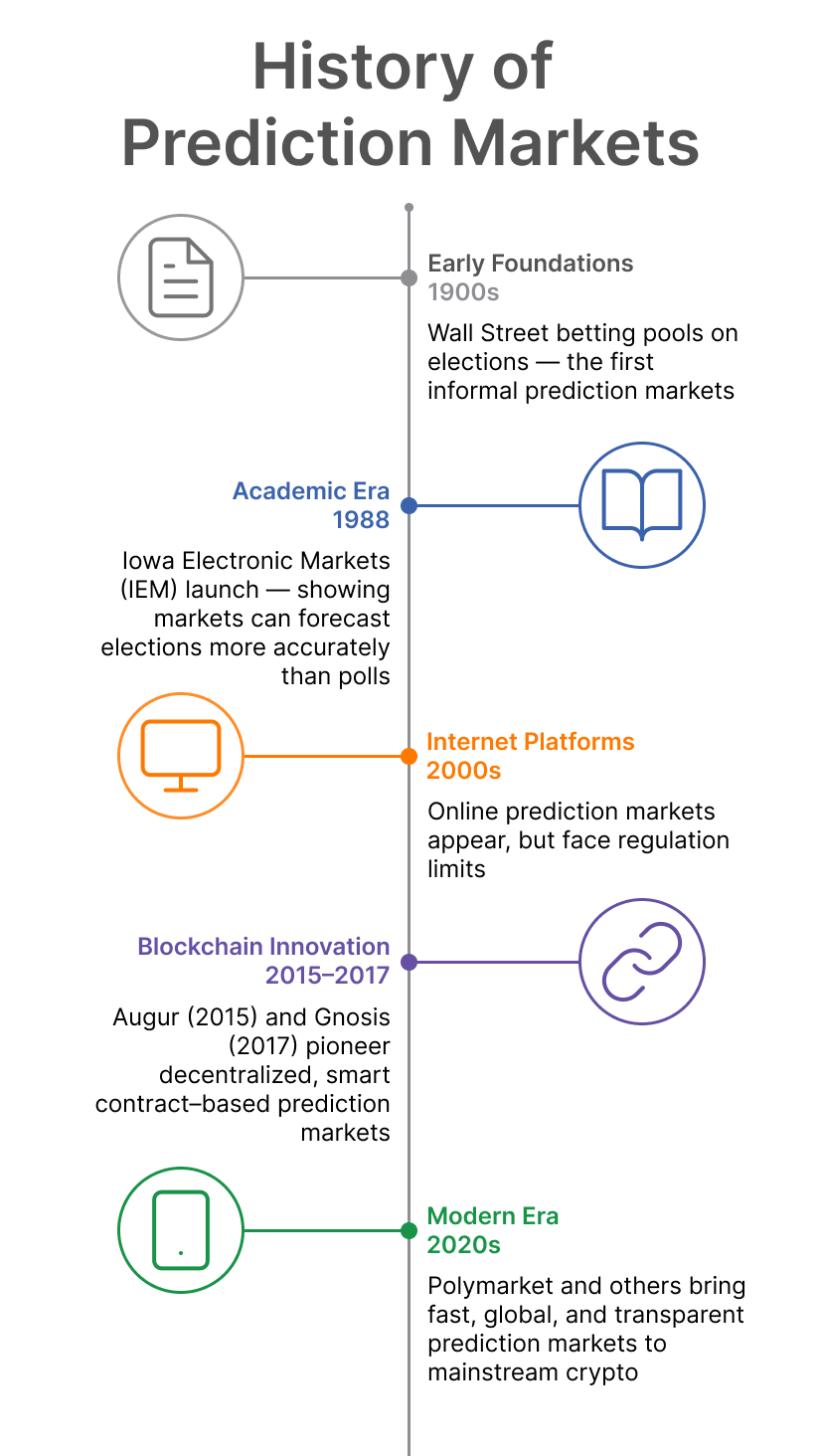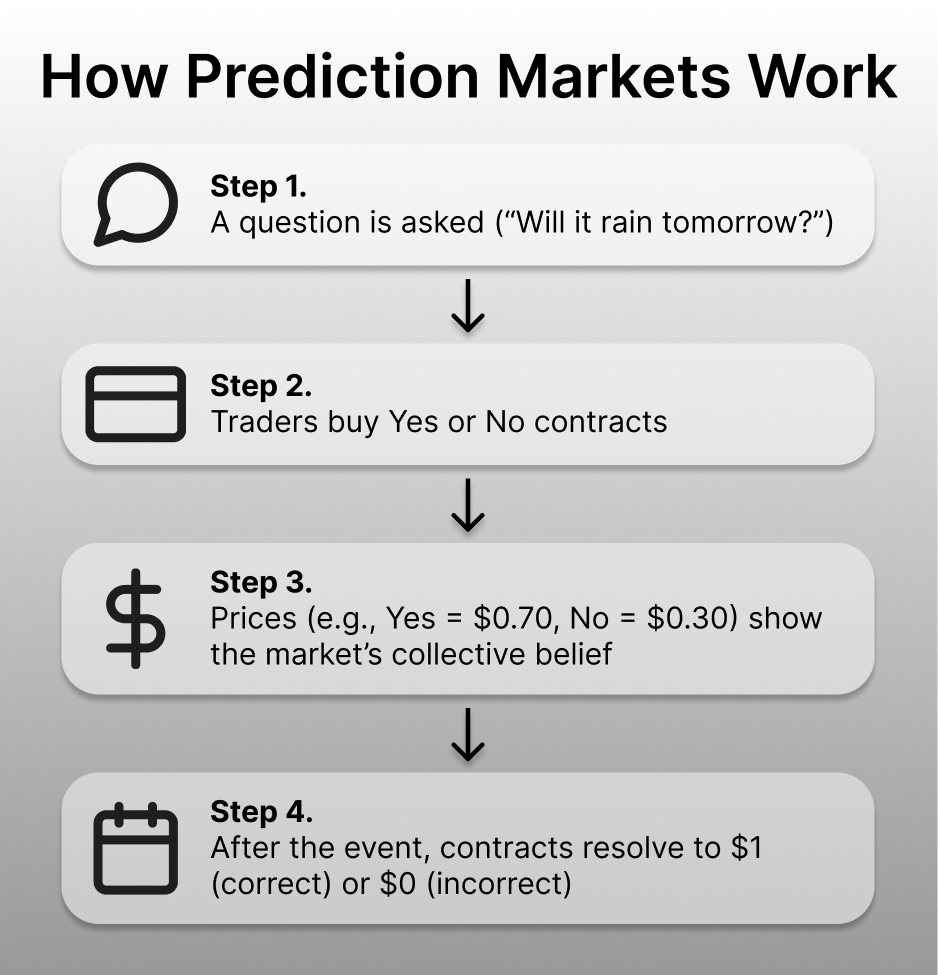Have you ever wondered what other people think about the chances of an event happening—like who might win an election, whether interest rates will rise, or how your favorite team will perform? Or maybe you’re the kind of person who enjoys making predictions and often turns out to be right. If so, you might be interested in prediction markets, especially as they move onto the blockchain.
Disclaimer: This article is for educational purposes only and does not constitute financial advice. Prediction markets involve risk, and you should always do your own research before participating.
A Brief History of Prediction Markets
While they may seem like a modern innovation, prediction markets have been around in various forms for centuries.
- Ancient Traditions: The practice of betting on future outcomes goes back thousands of years. Ancient civilizations wagered on athletic competitions, political events, and even fate-driven outcomes. In Europe, betting on elections was common centuries before the U.S.—including parliamentary contests in the U.K. and papal elections in 16th-century Italy. While these early forms weren’t “prediction markets” in today’s sense (they lacked mechanisms for reselling or trading positions), they reflected the same human instinct to speculate on the future.
- Early 20th Century: Informal betting markets on political elections existed on Wall Street and in other venues, where traders speculated on candidates long before official polling became common.
- 1980s–1990s: Academics began to formalize prediction markets. The Iowa Electronic Markets (IEM), launched in 1988, became one of the earliest structured platforms, showing that markets could forecast election outcomes with surprising accuracy.
- 2000s: Internet-based prediction markets appeared, covering elections, sports, and finance. While these broadened access, many faced legal and regulatory hurdles, especially in the U.S., which limited their growth.
- 2010s–Present: Blockchain Prediction Markets: The rise of blockchain brought a new wave of innovation. Platforms like Augur (2015) and Gnosis (2017) were among the first decentralized prediction markets, aiming to remove reliance on intermediaries and use smart contracts for transparency and trust. More recently, Polymarket has emerged as a leading blockchain-based platform, combining fast settlement, a user-friendly interface, and broad coverage of real-world events.
Blockchain prediction markets stand out because they are:
- Global – anyone with internet access can participate.
- Transparent – outcomes and transactions can be verified on-chain.
- Resilient – they operate without a single central authority controlling them.
This evolution shows how prediction markets have gone from small academic experiments to global, blockchain-powered ecosystems that provide real-time insights into everything from elections to economic trends.

How They Work
A prediction market is a platform where people trade contracts based on the outcome of future events. Each contract represents a “yes” or “no” answer to a specific question.
Here’s a simple example:
- Question: “Will it rain in New York City tomorrow?”
- If you think the answer is yes, you might buy a contract priced at $0.70. If it does rain, the contract pays out $1.
- If you think the answer is no, you could sell or buy the opposite side, priced at $0.30. If it doesn’t rain, that side pays out $1.
The prices—$0.70 for “yes” and $0.30 for “no”—reflect the market’s collective view of the odds. In this case, traders believe there’s about a 70% chance of rain tomorrow.
These prices aren’t fixed; they shift as more people buy and sell shares. If you buy a “Yes” share at $0.30 and the market later moves to $0.70, you could resell it at a profit before the event even happens. If you hold until the outcome is known, your payout depends on the price you originally bought in at: a winning share always settles at $1, regardless of where the market ended.
Going against the majority view is riskier—if most traders think “Yes” and you bet “No,” the odds aren’t in your favor. But if you’re right, your return will be much higher relative to your entry price, since you bought when “No” shares were cheap.


Why Prediction Markets Are Useful
Prediction markets can be powerful because they bring together information from many different people. Instead of relying on a single poll, forecast, or expert, prediction markets let everyone contribute their knowledge or research—backed by real money. This creates strong incentives for participants to be thoughtful, since they stand to gain or lose depending on how accurate they are.
Over time, prediction markets have been shown to often produce forecasts that are as accurate, or sometimes even more accurate, than traditional polls or expert predictions.
Real-World Examples
Today, prediction markets cover a wide range of topics:
- Elections – Who will win an upcoming race?
- Economics – Will inflation rise above a certain level? Will interest rates be cut?
- Politics – Will a certain law be enacted? Will a global conflict be resolved by a certain date?
- Sports & Entertainment – Which team will win the championship, or will a movie break box office records?
- Science & Technology – When will a new discovery or innovation happen?
Platforms like Polymarket have made prediction markets more accessible, allowing people around the world to trade on questions tied to real-world events.
Risks and Limitations
While prediction markets can be insightful, they aren’t perfect:
- Liquidity: If too few people trade, prices may not reflect meaningful odds.
- Regulation: In many countries, prediction markets face restrictions or uncertainty because they can resemble gambling. However, unlike pure gambling, prediction markets are designed to aggregate information and generate probabilistic forecasts, making them useful tools for research, decision-making, and understanding public sentiment.
- Bias: Prices can sometimes reflect traders’ personal hopes or beliefs rather than objective analysis.
- Event Clarity: Markets are only as good as the questions they ask—ambiguous or poorly worded questions can lead to disputes.
- Platform Trust: When the outcome of an event is ambiguous, prediction market platforms may have to make judgment calls on how to resolve it. This can create controversy if users feel the decision benefits the platform more than its traders—for example, the dispute over how to settle a market related to President Zelensky wearing a suit.

At their core, prediction markets are a way to turn collective knowledge into a measurable forecast. Instead of just asking people what they think, prediction markets let them put their money where their mouth is—and the resulting prices give everyone a real-time snapshot of what the majority believes will happen.
In short, prediction markets aren’t about fortune-telling; they’re about gathering and aggregating information to better understand public sentiment and harness the wisdom of the crowd.
Thank you for checking out our article on What are Prediction Markets! Don't forget to download Enkrypt for a seamless web3 multichain wallet experience. We would love to hear from you on our social media about any guide suggestions you have for the future. Also, if you enjoy using mobile cryptocurrency wallets, give our MEW Mobile app a try, it's available on both iOS and Android platforms!

